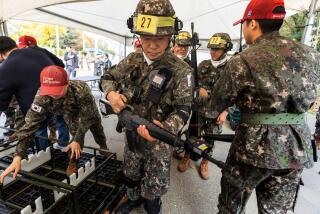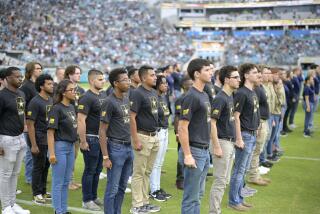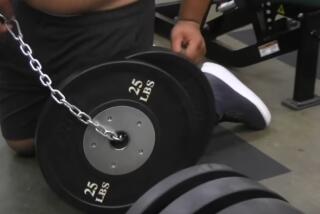At War With the Fat of the Land
- Share via
In combat, soldiers live and fight in boots. That’s why when I was in the military a decade ago, we did all our physical training, including long runs, in boots. Today in basic training, they run in lightweight running shoes.
In combat, soldiers must surmount obstacles such as walls. Obstacle courses in basic training still have walls, but if you can’t climb over them, you’re allowed to run around them. That’s fine if the enemy has erected walls only a few feet wide, but few are so obliging.
Although the military is more mechanized than ever, soldiers in war still find that often their main form of “transportation” is their feet. But not in training. The route of the 20-kilometer road march at Ft. Knox has been changed to avoid Heartbreak Hill because hiking over it was too difficult.
The situation also is bleak throughout the services. A 1996 Pentagon study found that a fifth of troops under 21 were overweight. “This is the Nintendo generation, the couch potato generation, and I’m really afraid of what’ll happen when they go into combat,” said one drill sergeant. “If we sent these kids to war, you’d have sick calls out the ying yang. Or they’d all be dead.”
Other drill sergeants have said that poor physical condition is “the biggest problem we face in the military.”
What has happened?
The nation as a whole just keeps eating more and moving around less.
Restaurants serve steaks the size of small calves and pile the pasta so high you practically need oxygen tanks to get to the top. A Butterfinger candy bar (aptly named “The Beast”) is seven times larger than one of the most popular candy bars in Europe, while 7-Eleven sells Cokes 10 times the size of the original Coca-Cola bottled servings.
At the same time, we keep finding ingenious ways to become more sedentary. Lawn mowers are being developed that will mow your yard while you sit back gulping your bathtub-sized cola and eating your “beast.” Americans now watch an average 4.4 hours of television a day while complaining, of course, that “there’s nothing good on.”
Children bear the brunt of these trends. In the l960s, physical education was required and real. It was wind sprints, circuit training, long runs, push-ups, pull-ups.
Increasingly though, PE is becoming elective or replaced by classes in which students learn how to stretch a condom over a banana. By 1990, only 42% of high school students had mandatory PE; in 1995, that had fallen to 25%.
This didn’t haunt us in the Gulf War, in part because in 1990 our soldiers were in better shape and in part because the conflict was mechanized and fought almost entirely at long range.
Now we are in an era of “small wars,” in which massive firepower takes second place to the ability of the individual soldier armed with a light weapon. In one such war, a small unit of Army rangers armed with little more than small arms was ambushed by a huge Somali force. The rangers nevertheless inflicted 10 enemy casualties for each of their own and extricated themselves.
As the obesity epidemic worsens, our ability to fight such conflicts has been severely compromised. We’ve already got a military that gives a whole new meaning to the expression “doughboys.”


